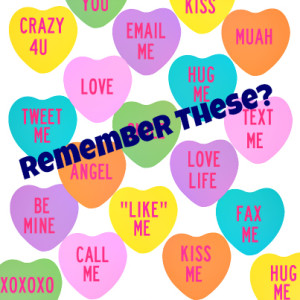 Do you remember getting — or giving – those pastel candy hearts and secretly hoping that you’d get one with a special message? Maybe you still share them with those special to you – or help your kids pick the ones they want to share.
Do you remember getting — or giving – those pastel candy hearts and secretly hoping that you’d get one with a special message? Maybe you still share them with those special to you – or help your kids pick the ones they want to share.
“Be Mine,” “Kiss me,” “XOXO”
The brightly colored hearts with familiar sayings — known as conversation hearts, motto hearts, and sweethearts — have been a Valentine’s Day treat since 1902. Their manufacturer, NECCO, the New England Confectionery Company in business since 1847, sells more than 8 billion candy conversation hearts a year.
How Did Candy Conversation Hearts Get To Be A Symbol Of Valentine’s Day?
Giving a gift of candy with an inscribed message can be traced back to the American colonists who shared homemade hard candy with messages etched into the surface with their sweethearts.
Years later after developing the process of printing red vegetable dye mottos on candy, the founder of NECCO and his brother turned this tradition into a business.
The candy’s original shape wasn’t a heart, but a seashell shape called a “cockle.” A message was written on a colored slip of paper that was wedged into the cockle’s shell.
NECCO started producing candy with mottos stamped on them in 1900, but the candy was shaped like horseshoes and baseballs that allowed for longer printed sayings like “How long shall I have to wait?” and “Pray be considerate.” The candy called Sweethearts wasn’t shaped as a heart until 1902.
The original candies with printed sayings were called “motto hearts.” The sayings and flavors have been updated over the years with new ones added periodically. Some of the newer flavors are strawberry, green apple, lemon, grape, orange, and blue raspberry and new sayings include “Tweet Me,” “Text Me,” “You Rock,” “Soul Mate,” “Love Bug,” and “Me + You.”
Candy Heart Facts
NECCO still uses the original recipe, process, and machines they used at the turn of the century to make the candy, producing 100,000 pounds a day. It takes about 11 months to produce the more than eight billion pieces — or about 13 million pounds – of colorful candy sweethearts that are sold in the six weeks before Valentine’s Day. The little hearts with messages account for 40% of the Valentine candy market, just behind – you guessed it – chocolate!
Although you’d be hard pressed to call them nutritious, the candy hearts are fat free, sodium free, and a caloric bargain at about 3 calories for each small heart and about 6 calories for each larger “Motto” heart.

Leave a Reply